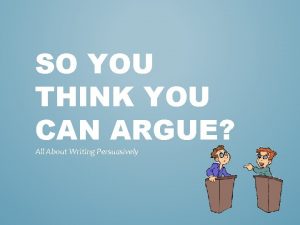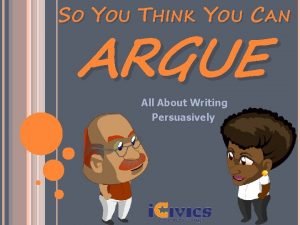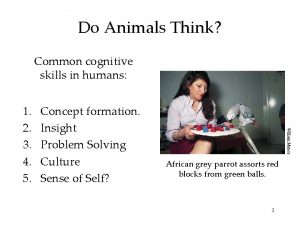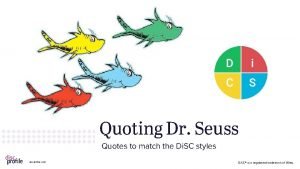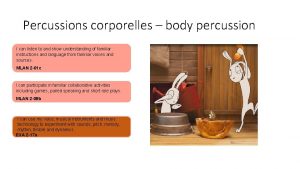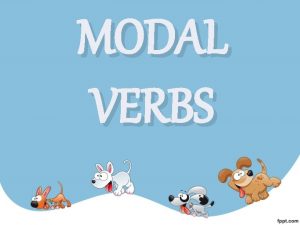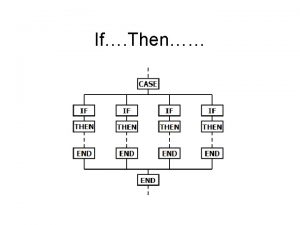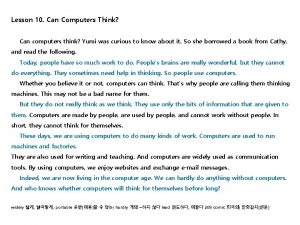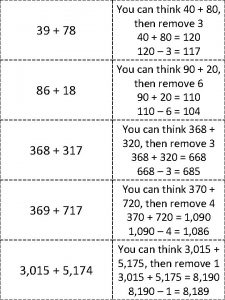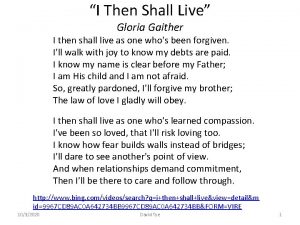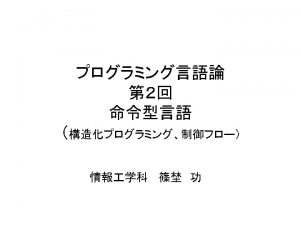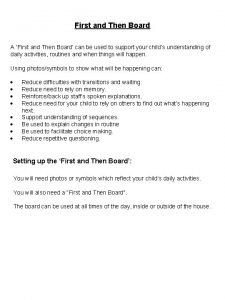If I can think it then I can

















- Slides: 17

“If I can think it, then I can say it. If I can say it, then I can write it!” —J. Schaffer Writing a ONE-Chunk Paragraph Jane Schaffer – Edited by Crystal Russell

The Hamburger – think BIG Mac with 2 all beef patties • Color Coding for Prewriting and Rough Drafts Claim/Topic Sentence Concrete Detail/Data/Evidence (data) Commentary/Warrant/Explanation (CM) Commentary/Warrant/Explanation(CM) Concluding Sentence/Clincher • A ONE-Chunk paragraph is SEVEN to EIGHT sentences.

The “Chunk” • • Claim Data Commentary: CM Commentary : CM A “chunk” consists of 2 data sentence(s) and 2 commentary sentences for each data.

Claim • • 1 st sentence in body ¶ The SUBJECT of your ¶ Tells what whole ¶ is about (the MAIN IDEA) Your OPINION includes COMMENTARY words states your claim – what you are going to prove

Example: Claim NOTE: When writing only one paragraph the claim must include the title and the author of the story (TAG). • title & author: In “Cinderella, ” by Charles Perrault, • main idea: the stepmother is cruel. • In “Cinderella, ” by Charles Perrault, the stepmother is cruel.

Concrete Detail/DATA • • Follows claim in a One-Chunk ¶ The “STUFF from the STORY” The evidence/proof that supports claim in the TS A data is so SPECIFIC that you can say on which page it occurred. Always write down (cite) from which page it came. You cannot disagree with a data. It either happened or it didn’t. PARAPHRASE what happens in the story (put in your own words) OR use a direct QUOTATION Always write the data sentence in T, L, DATA (#). Format (4 parts to the sentence)

T, L, DATA (author’s last name #). Format Concrete Detail (cont. ) • T = transition (i. e. For example, In addition, Secondly, Lastly, ). Begins your data sentence; followed by a comma For example, • L = lead-in phrase (begins with a word like after, when, since, although). Gives your reader background details/information from the story; the lead-in phrase “sets-up” your evidence (data); followed by a comma GIVES YOUR READER CONTEXT when the Prince sends his men to find the lady whose foot fits the glass slipper, • DATA = Concrete Detail (the specific thing that happened in the story that supports/proves your claim in the claim) THE QUOTE “the stepmother locks Cinderella in her room and does not let her try it on” • Citation = (author’s last name #). (must use MLA format); the number of the page(s) on which the data occurs. The NUMBER ONLY inside parenthesis FOLLOWED by a PERIOD. (Perrault 6).

Example: DATA Sentence in T, L, data Format • Transition: For example, • Lead-in Phrase: when the Prince sends his men to find the lady whose foot fits the glass slipper, • DATA: “the stepmother locks Cinderella in her room and does not let her try it on” • Citation: (Perrault 6). • For example, when the Prince sends his men to find the lady whose foot fits the glass slipper, “the stepmother locks Cinderella in her room and does not let her try it on” (Perrault 6). • DO NOT write a FRAGMENT: For example, when “the stepmother locks Cinderella in her room and does not let her try it on”(Perrault 6).

Commentary • The “STUFF from YOUR HEAD” • CM = Analysis, Opinion, Insight, Interpretation • A person can agree or disagree with it and not be wrong. • DIG DEEPER for INSIGHTFUL commentary • Gives original thought about the quote. • Tells the reader something they may not have already figured out. (Commentary does NOT state the obvious!) • MUST include CM WORDS = words with feeling attached to them (person vs. hero, quiet vs. lonely)

Helpful Tips for Writing Insightful Commentary • Begin CM sentences in prewriting and rough drafts with the following phrases: This shows that…. This also shows that…, This is important because…, This reveals that…. , This implies…. • Remember: These phrases MUST be REMOVED from FINAL DRAFT! Use STRONG verbs! (i. e. does not like vs. resents) • Avoid “No-No” words – see orange sheet on wall • CM sentences do NOT give advice

Common CM Mistakes • Commentary is generic (i. e. He is mean. vs. He is angry to be in this situation. ) • Commentary strays from Claim/DATA – doesn’t relate to main idea (apples in a cherry tree) • Commentary is really DATA (i. e. Chewy is 7 feet tall. ) • CM repeats (ie. They are in danger. followed by They are not safe. vs. Chewy protects Princess Leia. He feels responsible for her. ) • CM contradicts the Claim (i. e. Claim: Chewy is scary. CM: Leia never thought he would hurt her. )

Example: Commentary Sentences • CM (1): This shows that she is jealous of Cinderella. • CM (2): This also shows that the stepmother resents Cinderella. FIRST DRAFT OF CM sentences: • She is jealous of Cinderella. The stepmother resents Cinderella. (Just ok– need to DIG DEEPER!) SECOND DRAFT of CM sentences: • She is jealous of Cinderella’s beauty. The stepmother resents Cinderella and does not care about what is important to her. (MORE INSIGHTFUL and includes more CM words)

Concluding Sentence • Last sentence in a body ¶ • Sums up your main idea, but must NOT repeat key words • All Commentary (MUST include CM words) from YOUR HEAD • Gives a finished feeling/closure to ¶

Example: Concluding Sentence • The stepmother is determined to keep Cinderella from experiencing any happiness in her life.

Example of a One-Chunk Paragraph ROUGH DRAFT (#1) – COLOR CODED Student’s Name Mrs. W. Nugent English I, Period 7 20 November 2015 The Resentful Stepmother In “Cinderella, ” by Charles Perrault, the stepmother is cruel. For example, when the Prince sends his men to find the lady whose foot fits the glass slipper, “the stepmother locks Cinderella in her room and does not let her try it on” (Perrault 6). This shows that she is jealous of Cinderella. This is important because the stepmother resents Cinderella. As a result, she is determined to keep Cinderella from experiencing any happiness.

Example of a One-Chunk Paragraph ROUGH DRAFT (#2) – COLOR-CODED Student’s Name Mrs. W. Nugent English I, Period 7 20 November 2015 The Heartless Stepmother In “Cinderella, ” by Charles Perrault, the stepmother is cruel. For example, when the Prince sends his men to find the lady whose foot fits the glass slipper found at the ball, “the stepmother locks Cinderella in her room and does not let her try it on” (Perrault 6). This shows that She is jealous of Cinderella’s beauty. This is important because The stepmother resents Cinderella and does not care about what is important to her. The stepmother also pushes her daughters into mutilating themselves in order for their feet to fit into the glass slipper. This shows that she cares more for her own welfare than she does her own offspring. This shows that The stepmother is willing to do anything to earn a position of power in the kingdom. As a result, the stepmother proves that she is a selfish woman who does not care for Cinderella or anyone else but herself.

Student’s Name Revised– BLACK INK Mrs. W. Nugent English I, Period 7 20 November 2015 The Heartless Stepmother In “Cinderella, ” by Charles Perrault, the stepmother is cruel. For example, when the Prince sends his men to find the lady whose foot fits the glass slipper found at the ball, “the stepmother locks Cinderella in her room and does not let her try it on” (Perrault 6). She is jealous of Cinderella’s beauty. The stepmother resents Cinderella; therefore, she is not concerned with what is important to her. She is determined to keep Cinderella from experiencing any happiness in her life. The stepmother also pushes her daughters into mutilating themselves in order for their feet to fit into the glass slipper. She cares more for her own welfare than she does her own offspring. She is willing to do anything to anyone to earn a position of power in the kingdom. The stepmother proves that she is a selfish woman who loves no one but herself.
 Mukesh ambani signature
Mukesh ambani signature If you think you can you can poem
If you think you can you can poem Think said the robin think said the jay
Think said the robin think said the jay Think fam think
Think fam think What is sweetened then soured boiled then cooled
What is sweetened then soured boiled then cooled So you think you can argue
So you think you can argue You can argue
You can argue Have a daughter so you can argue
Have a daughter so you can argue Can animals think and exhibit language
Can animals think and exhibit language Oh the thinks you can think quotes
Oh the thinks you can think quotes Can can body percussion
Can can body percussion Vermögensstruktur kennzahl
Vermögensstruktur kennzahl Look at the pictures and complete with can or can't
Look at the pictures and complete with can or can't Kinds of comparison
Kinds of comparison Already can or can already
Already can or can already You can tell harris about it just ____(easily) as i can
You can tell harris about it just ____(easily) as i can The modal verb can is used to express
The modal verb can is used to express Going on a bear hunt with dr jean
Going on a bear hunt with dr jean






